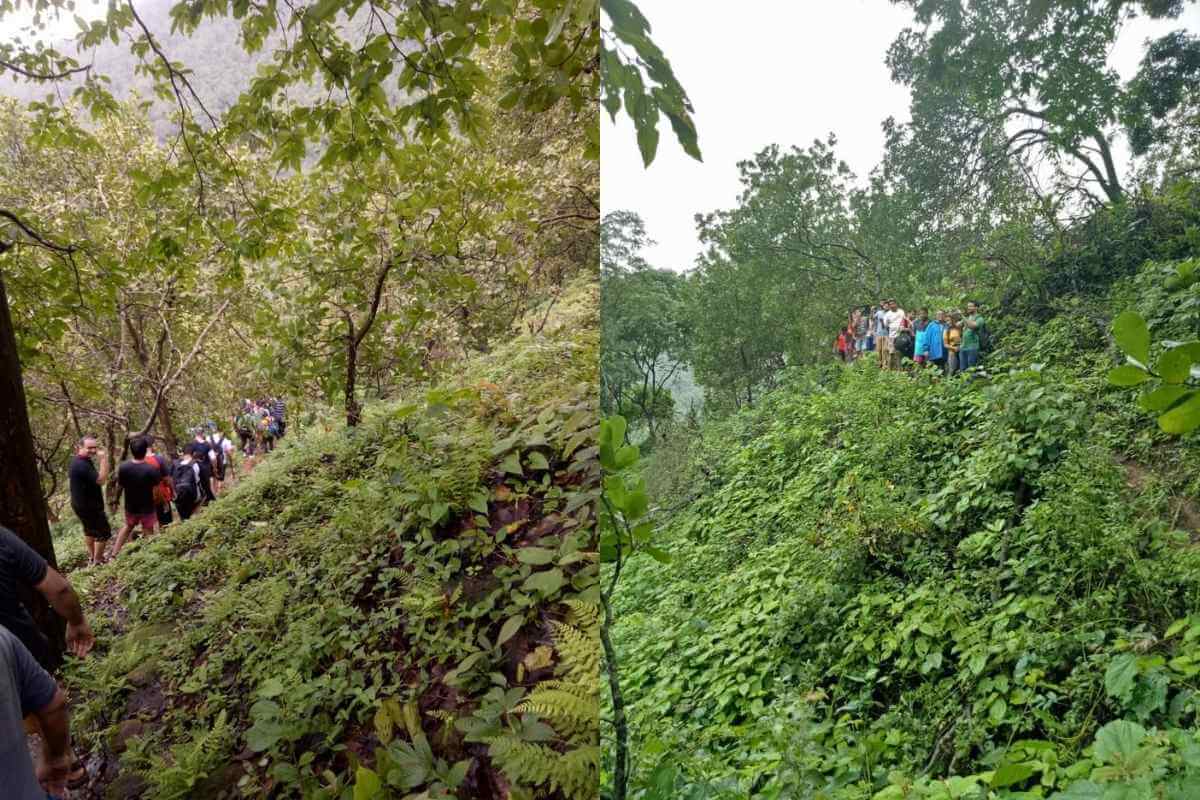As raindrops descend upon the lush green landscape, Goa comes alive with a multitude of captivating celebrations. From the energetic Sao Joao festival, where revellers jump into overflowing wells with joyous abandon, to the vibrant Bonderam festival, filled with colourful flags and spirited mock battles, Goa’s monsoon festivities are a sensory delight.
The electrifying beats of live music, the aroma of delectable Goan cuisine, and the sight of locals dressed in traditional attire create an immersive experience like no other. Whether you’re captivated by the rhythmic dance performances of Ganesh Chaturthi or enchanted by the unique Dahi Handi celebrations, Goa’s hottest monsoon festivals promise an unforgettable journey into the heart of Goan culture and traditions. So, grab your umbrellas and immerse yourself in the pulsating monsoon festivities that make Goa truly magical during this time of the year.
Sangodd Festival
Goa is a land with a rich cultural heritage. People of various faiths celebrate unusual holidays like the Sangod. Everyone is invited to join in the celebrations, yet the spirit of the occasion never fades. This is what distinguishes Goa and keeps tourists coming in droves. Goa observes the Sangodd festival on June 29 every year. The feast days of Saints Peter and Paul are celebrated on this day. This celebration is highly significant to the fishing community since Saint Peter, a fisherman by trade, is the patron saint of all fishermen.
How is Sangodd Festival Celebrated?
On this day, which marks the beginning of the “rampon” fishing season, the sea is blessed and the boats are prepared for the next fishing season. Making a “Sangodd,” which is constructed by combining three to five boats, symbolizes St. Peter and St. Paul’s contributions to the construction of the Catholic Church and is done to honor the celebrations. On this day, fishermen memorialize their lost coworkers and give petitions to the Almighty by saying prayers and litanies.
The St. Cruz Chapel Committee, which consists of 10 individuals, organizes “Sangodd” yearly in Candolim. Several Candolim residents said that Orda was home to several fishing families. Their ancestors observed the celebration of ‘Sangodd’, a ritual that has been around for more than 150 years. “Sangodd” begins at the Orda jetty at 3:30 p.m. and used to make six more stops in the sea so that spectators gathered in various areas could see the celebration. Generations have continually continued the festival celebration custom, and with time, their devotion to the Saint has grown.
Origin of Sangodd Festival
The Cumbharjua Vodekar dynasty is thought to have erected a Lord Ganesha statue inside the Shantadurga Cumbharjuvekarin temple in the 15th century. They cherished their devotion to Lord Ganesha and were forced to make this decision on Ganesh Chathurthi because of a financial need. They crossed the canal in a canoe (voddem) on the day of the immersion. No one will know for sure, but this may be one of the likely causes for the beginning of this varied and distinctive Goan celebration.
Cumbharjua’s citizens also think that the event must be observed to spare their community from Goddess Shantadurga’s wrath. Nevertheless, the celebration has now developed into a custom in which a Ganesh statue is installed in the temple as well as the locals’ houses.
Chikal Kalo – The Mud Festival
The Marcel Devaki Krishna temple hosts the Chikal Kalo, or mud festival, in the middle of July. Wet mud is referred to as Chikal. The villagers celebrate Lord Krishna’s joyful nature by dancing and engaging in activities in the muddy, rainy monsoon muck. Men congregate at the temple to worship while dousing their bodies with oil. Goa is the only place where Chikal Kalo (or Chikhalkala) is a monsoon celebration. It is observed in the premises of the Devki-Krishna temple in Marcel, a village in North Goa’s Ponda Taluka. This distinctive celebration, also known as the Goa Mud celebration, is similar to the celebrated tomato festival across the world.
The celebration of Chikhal Kalo is distinctive to the village of Marcel; here, everyone unites despite their differences to sing devotional songs and engage in a variety of sports to mark the occasion. It is thought that it was historically commemorated in Marcel as a representation of the young Lord Krishna, who adored playing with his pals in Vrindavan. The Devaki-Krishna temple in Marcel serves as the backdrop for the entire action.
How is Chikal Kalo Celebrated?
Village men start the festivities by applying oil to themselves. Then enjoyable games and pastimes are performed, evoking the games that Lord Krishna and his companions used to play when they were kids. Music played on traditional Goan instruments enhances the joyful mood. Sweets, particularly puran poli, are given out to everyone at the conclusion. The playing of dahi handi marks the festival’s conclusion. The village’s younger residents get together to create a human pyramid. Later, they break the clay butter pot that is fastened to a peepal tree limb above. This celebratory event is a vibrant and young demonstration of youth. All participants leave their everyday concerns and join in the joyful celebration, savouring the moment wholeheartedly.
Origin of Chikal Kalo
The event honours Bal Krishna, often known as the Baby Krishna, for his impish behaviour. Krishna is well-known for his youthful mischief with his mother and other residents of Braj Bhumi, as those of us who study Hindu scriptures and traditions are aware. This particular aspect of Krishna is honoured at Marcel.
Touxeachem Fest – The Cucumber Festival
As alive and bright as its nightlife is Goa’s cultural liveliness. Cucumber is the precise translation of the Konkani term “Touxeachem,” which is used to describe this festival, which is held at Talaulim in Tiswadi’s magnificent Church of St. Anne. Every year, the town is decorated with brilliant colors and a happy environment to welcome followers from all over the world!
How is Touxeachem Fest Celebrated?
There is a widespread belief that couples without children who come here to pray for a child will eventually have their desires granted. Here, they venerate St. Anne, who after forty years of being infertile, was blessed with a child—Mother Mary. At the feet of the statue of St. Anne, devotees lay cucumbers. Both childless couples and newlywed couples want children. People who want a male baby donate cucumbers, while those who want a girl baby provide bangles.
Origin of Touxeachem Fest
This festival dates back to St. Anne and St. Joachim, Jesus Christ’s grandparents. It is believed that they went nearly two decades without having children. Despite being wealthy and content with their marriage, they had to put up with the jeers of their community since they were unable to have children. It got to the point that the priest of their temple declined to accept St. Joachim’s contributions, seeing his infertility as a manifestation of “divine displeasure”. St. Joachim had a dream that he would be rewarded with a child who would serve God after making numerous prayers. St. Anne indeed gave birth to Mary at the age of 40; she later left the child in the temple so that she may serve God.
Patolleanchem Feast- For the sweet tooth
In August, when there are several harvest celebrations, Goa is the place to come if you have a sweet taste. Along with India’s Independence Day, August 15 is also observed as the feast of “Mother Mary’s Assumption into Heaven” by a large number of Christians worldwide. One custom followed by Goans to remember this feast is the preparation of a sweet dish called “Patolleo.” In a sense, the harvest celebration is also known as patolleo, a traditional sweet dish created from the fresh paddy (rice) that the harvest delivers, coupled with shredded coconut and jaggery on turmeric leaves.
How is Patolleanchem Feast Celebrated?
The Patolleos are prepared and distributed to the locals as part of the festival’s customary celebration. Then, visitors are treated to delicious Goan cuisine and a variety of local and international acts. The handmade Patolleos that are customarily served on this day are also shared with the visitors, it said. Additionally, a variety of stalls are set up to exhibit local goods and handicrafts. The omnipresent Goan brass band also adds color to the event with lively Konkani classics and appealing melodies, according to the department.
Origin of Patolleanchem Feast
The Patolleanchem Fest is distinctive because it celebrates the jaggery-based dessert known as patolleo. It portrays the vibrant ancient Goan culture and teaches the younger generations the skills used by the elders. It also becomes pertinent since at this moment, less well-known aspects of Goan culture and legacy are becoming more well-known. Due to the abundance of love and camaraderie shared throughout the festivities, this festival serves as a fantastic means of bringing the villagers together.
Bonderam- Festival Of Divar Island
Goa is vivacious day or night. But the Bonderam Festival is something unique that electrifies the state even more. Every year, the event is held on the fourth Saturday of the month of August. This event is one of the most important ones in Goa.In contrast to other days, there are lengthy lines to board the jetty today. The event not only draws Goans, but also a large number of foreign visitors, who in turn bring with them a large number of hawkers who set up shop along the Mandovi.
How Bonderam Festival Celebrated?
The event opens to calming music. Later in the afternoon, a unique procession is planned, when both sides participate to the best of their abilities and promote their respective communities. In addition to this, there are spoof clashes that simulate the genuine wars of the past. This festival’s activities and events are all fascinating and interesting. This event and all of its neighborhood-based activities promote mutual understanding and cultural tolerance.Due to the river island’s lack of commercialization, this festival nevertheless has a strong allure. The floats are independent of funding, and even if they lack elegance, you can still feel the youth’s heart, soul, and sweat in them. They have a fantastic platform to display their originality here. 2015’s floats featured themes like fish and crabs, which are a staple food in Goa and without which no dinner can be complete. Newly wed couple are often seen with flowers on a float showing flowers, and another featured local artisans creating furniture out of wood.
Women also promote the Clean India initiative while holding brooms in their hands. Young women danced while holding fish baskets filled with thermocol-stuffed fish.
Origin of Bonderam Festival
Goa had a number of bloody conflicts between Sao Mathias and Piedalda during the Portuguese conquest era. These two areas made up Divar Island Village’s two wards. Land ownership was the primary cause of this animosity. As the days passed, the feuds grew more violent and began to cause a severe tremor across the region. In light of this, the Portuguese government opted to mark off distinct land parcels with vibrant flags. It was truly designed to urge people to love and forgive one another as well as to cease the feuds. The locals, however, who were tenacious and relentless, made the decision to pull down the flags. Thus, they acted.
Ponsachem Fest
When the entire state is anticipating Sao Joao, the town of Socorro in North Goa will be holding their Ponsachem festival. The jackfruit is the main focus of the event, which also showcases a range of local delicacies cooked with it. The Jackfruit Festival, which was held for the first time in Goa last year, will now be in its second year. Jackfruit is referred to as panas in Konkani, which is the same word as in Sanskrit.At the Ponsachem celebration, also known as the Jackfruit festival, residents in Goa honor the native but undervalued jackfruit tree by donning costumes that are based on the tree and consuming the fruit in a variety of ways.
How is Ponsachem Festival Celebrated?
The Ponsachem festival, which was held in June, fell on the same weekend as Sao Joao celebrations throughout the state. The event was run entirely by volunteers and the local community; there were no main sponsors, no alcohol, and no plastics. Food and beverages were served on leaf plates and in coconut shell cups.
Ponsachem Fest, which also took place in 2022, concentrated on the fruit of the tree with live demonstrations and tastings of a wide range of goods with added value. “More than a hundred different dishes can be prepared from the jackfruit, right from when it is tender and immature, to its unripe, mature stage, to when it is fully ripe,” said Sunetra Talaulikar, a home scientist with the Indian Council of Agricultural Research. The audience at the event watched Talaulikar’s crew make jackfruit halwa, bajias or fritters, and cutlets.
Origin of Punsachem Fest
“The jackfruit is endemic to this part of the world,” researcher Dr. Fatima Gracias da Silva said in her book Cozinha de Goa, which chronicles the development of Goan cuisine. The soft untainted fruit is used in several Goan Hindu dishes as a vegetable and in both sweet and savory dishes. In the 17th century, the Portuguese brought it to Bahia in Brazil, and in the beginning of the nineteenth century, they brought it to Sao Tome in Africa.






























